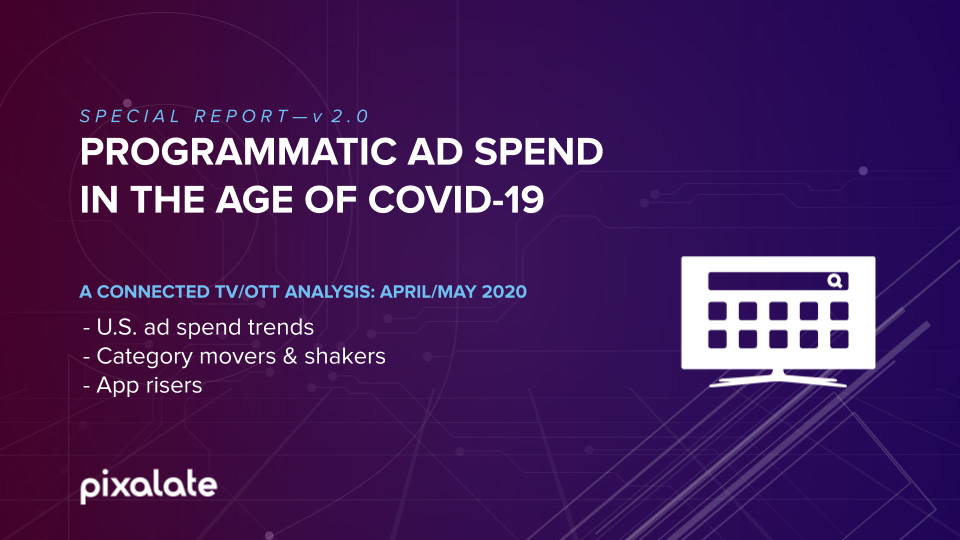
Hulu (+44%), Sling TV (+30%) among notable app risers; All major device types see ad spend bump, including Roku (+44%) and Apple (+41%)
PALO ALTO, Calif., June 1, 2020 -- Pixalate, a global ad fraud intelligence and marketing compliance platform, today released an update to its COVID-19 benchmarks: Programmatic Ad Spend in the Age of COVID-19: Connected TV/OTT Advertising Report, examining how U.S. programmatic advertisers have shifted budgets during the ongoing pandemic.
The latest report details programmatic OTT/CTV ad spend patterns from April through May 2020.
These figures are based on Pixalate's analysis comparing the weeks of April 5-11 to May 10-16, 2020.
The report includes 20 notable Roku store apps that saw ad spend gains (based on programmatic ad transactions) in the time frame studied, according to Pixalate's research.
Below are some examples of fast-rising apps:
What's inside the report
Pixalate's Programmatic Ad Spend in the Age of COVID-19: Connected TV/OTT Advertising Report — Version 2.0 includes:
“After pulling back ad spend in March, OTT/CTV advertisers appear to be reinvesting in the ecosystem as consumers continue to stay home,” said Jalal Nasir, CEO of Pixalate. “All major device types saw ad spend gains in April and May, a promising sign that that OTT/CTV ad landscape is quickly regaining its footing.”
Download a free copy of the Programmatic Ad Spend in the Age of COVID-19: Connected TV/OTT Report — Version 2.0 today.
Follow Pixalate
About Pixalate
Pixalate, a global ad fraud intelligence and marketing compliance platform, works with brands and platforms to prevent invalid traffic and improve ad inventory quality. We offer the only system of coordinated solutions across display, app, video, and OTT/CTV for better detection and elimination of ad fraud. Pixalate is an MRC-accredited service for the detection and filtration of sophisticated invalid traffic (SIVT) across desktop and mobile web, mobile in-app, and OTT/CTV advertising. www.pixalate.com
Disclaimer
The content of this press release, and the Programmatic Ad Spend in the Age of COVID-19: Connected TV/OTT Advertising Report — Version 2.0 (the "Report"), reflect Pixalate's opinions with respect to factors that Pixalate believes can be useful to the digital media industry. Any insights shared are grounded in Pixalate's proprietary technology and analytics, which Pixalate is continuously evaluating and updating. As cited in the Report and referenced in the Report's key findings reproduced herein, programmatic ad transactions, as measured by Pixalate, are used as a proxy for ad spend. The Report examines U.S. advertising activity. Any references to outside sources in the Report and herein should not be construed as endorsements. Pixalate's opinions are just that, opinions, which means that they are neither facts nor guarantees.
MEDIA CONTACT
info@pixalate.com
*By entering your email address and clicking Subscribe, you are agreeing to our Terms of Use and Privacy Policy.
These Stories on CTV
*By entering your email address and clicking Subscribe, you are agreeing to our Terms of Use and Privacy Policy.

Disclaimer: The content of this page reflects Pixalate’s opinions with respect to the factors that Pixalate believes can be useful to the digital media industry. Any proprietary data shared is grounded in Pixalate’s proprietary technology and analytics, which Pixalate is continuously evaluating and updating. Any references to outside sources should not be construed as endorsements. Pixalate’s opinions are just that - opinion, not facts or guarantees.
Per the MRC, “'Fraud' is not intended to represent fraud as defined in various laws, statutes and ordinances or as conventionally used in U.S. Court or other legal proceedings, but rather a custom definition strictly for advertising measurement purposes. Also per the MRC, “‘Invalid Traffic’ is defined generally as traffic that does not meet certain ad serving quality or completeness criteria, or otherwise does not represent legitimate ad traffic that should be included in measurement counts. Among the reasons why ad traffic may be deemed invalid is it is a result of non-human traffic (spiders, bots, etc.), or activity designed to produce fraudulent traffic.”

